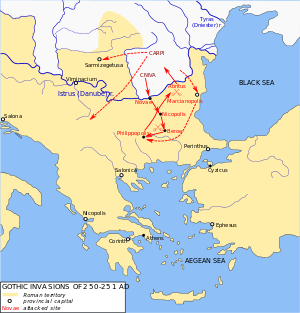251
| Millennium: | 1st millennium |
|---|---|
| Centuries: | 2nd century · 3rd century · 4th century |
| Decades: | 220s · 230s · 240s · 250s · 260s · 270s · 280s |
| Years: | 248 · 249 · 250 · 251 · 252 · 253 · 254 |
| 251 by topic | |
| Politics | |
| State leaders – Sovereign states | |
| Birth and death categories | |
| Births – Deaths | |
| Establishment and disestablishment categories | |
| Establishments – Disestablishments | |
| Gregorian calendar | 251 CCLI |
| Ab urbe condita | 1004 |
| Assyrian calendar | 5001 |
| Bengali calendar | −342 |
| Berber calendar | 1201 |
| Buddhist calendar | 795 |
| Burmese calendar | −387 |
| Byzantine calendar | 5759–5760 |
| Chinese calendar | 庚午年 (Metal Horse) 2947 or 2887 — to — 辛未年 (Metal Goat) 2948 or 2888 |
| Coptic calendar | −33 – −32 |
| Discordian calendar | 1417 |
| Ethiopian calendar | 243–244 |
| Hebrew calendar | 4011–4012 |
| Hindu calendars | |
| - Vikram Samvat | 307–308 |
| - Shaka Samvat | 172–173 |
| - Kali Yuga | 3351–3352 |
| Holocene calendar | 10251 |
| Iranian calendar | 371 BP – 370 BP |
| Islamic calendar | 382 BH – 381 BH |
| Javanese calendar | 129–130 |
| Julian calendar | 251 CCLI |
| Korean calendar | 2584 |
| Minguo calendar | 1661 before ROC 民前1661年 |
| Nanakshahi calendar | −1217 |
| Seleucid era | 562/563 AG |
| Thai solar calendar | 793–794 |
| Wikimedia Commons has media related to 251. |
Year 251 (CCLI) was a common year starting on Wednesday (link will display the full calendar) of the Julian calendar. At the time, it was known as the Year of the Consulship of Traianus and Etruscus (or, less frequently, year 1004 Ab urbe condita). The denomination 251 for this year has been used since the early medieval period, when the Anno Domini calendar era became the prevalent method in Europe for naming years.
Events
By place
Roman Empire
- July 1 – In the Battle of Abritus, the Goths defeat emperor Decius and his son Herennius Etruscus on swampy ground in the Dobruja (Moesia).
- In Rome, Hostilian, son of Decius, succeeds his father, while Trebonianus Gallus is proclaimed Emperor by the troops. Gallus accepts him as co-emperor, but an outbreak of plague strikes the city and kills the young Hostilian.
- The prosperity of Roman Britain declines during this period as the Germanic tribes of the Franks and Saxons, whose homelands are in Friesland and the Low Countries, make raids around the southeast coast.
- Gallus makes peace with the Goths, he permits them to keep their plunder, and offers them a bribe not to return.
- A fifteen-year plague begins in the Roman Empire.
Persia
- The Sassanid king, Shapur I, orders an invasion of the Roman East with the intent of finally capturing the jewel of Syria, Antioch (251–254).
By topic
Religion
- March – Pope Cornelius succeeds Pope Fabian as the 21st pope.
Births
- Anthony the Great, Christian saint (d. 356)
Deaths
- Saint Agatha
- July – August
- Decius, Roman emperor (killed after the battle of Abritus)
- Herennius Etruscus, Roman emperor (killed during the battle of Abritus)
- September 7 – Sima Yi, strategist of Wei (b. 179)
- Deng Zhi, minister under Liu Bei
- Empress Zhen, wife of Cao Fang
- Hostilian, Roman emperor (of plague in Rome)
- Origen (possible date)
- Wang Ling, general of the Kingdom of Wei
References
This article is issued from Wikipedia - version of the 4/14/2016. The text is available under the Creative Commons Attribution/Share Alike but additional terms may apply for the media files.
